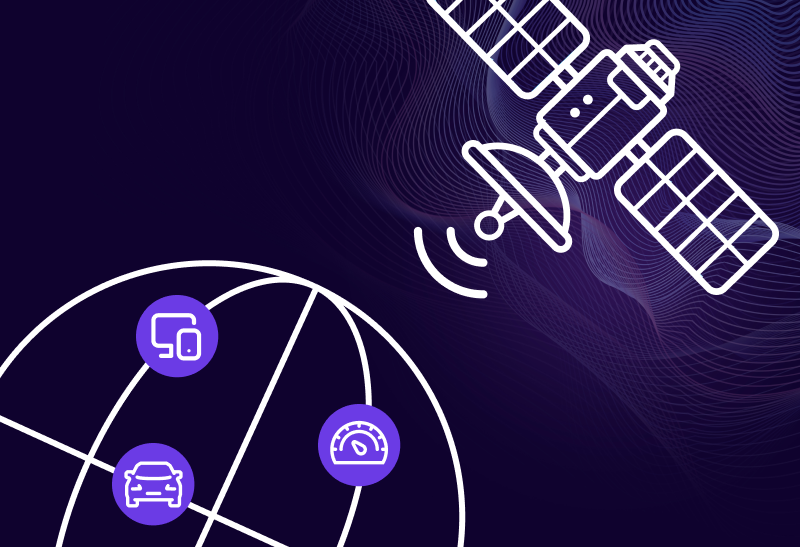

Quick definition: Satellite IoT services often use Low Earth Orbit (LEO) satellite networks or Geostationay Orbit (GEO) satellite networks to facilitate global connectivity. It serves as a standalone solution or a complement to “terrestrial networks” such as cellular connectivity. Progressive companies like emnify are taking this a step further by converging cellular and satellite connectivity, offering businesses greater network reliability and global reach, all on one SIM.
According to some estimates, more than 6,000 satellites orbit the Earth—around 3,000 of which are in LEO. Many of these satellites are owned by the same entities, enabling corporations and government agencies to network them together. While most people are familiar with satellite applications like GPS tracking, this technology has only recently been leveraged for other networking applications like Internet access.
Traditional IoT devices and their unique needs
IoT devices usually rely on cellular networks, which often have major limitations in terms of availability in remote locations. An example could be an oil rig in the middle of the sea or a remote location in a desert or in the mountains. A far better option would be a converged cellular and satellite connectivity solution for greater network reliability and global reach, reducing operational overhead in the process.
The emnify IoT SuperNetwork SatPlus offering converges cellular and satellite connectivity for uninterrupted global coverage on a single emnify SIM. This drastically simplifies the operational landscape of IoT connectivity, reducing both costs and the complexity of managing multiple hardware configurations and service providers.
Types of satellite IoT networks
A satellite constellation is a group of artificial satellites working together as a system. These constellations can provide permanent or nearly global coverage depending on how many satellites there are and their position in relation to the Earth. The bigger and denser the constellation, the closer it gets to providing real-time data.
Generally, there are three main types of satellite networks that can be leveraged for IoT connectivity: Low Earth Orbit (LEO), Medium Earth Orbit (MEO), and Geostationary (GEO). They’re characterized by orbital height, where they’re deployed, and ground coverage area. Some of these constellations are “stationary” (moving in sync with the Earth’s equator), while others move across the Earth.
3GPP Release 17 has specified the use of GEO and LEO satellites for IoT connectivity via Non-Terrestrial Networks (NTN).
LEO satellites have a smaller coverage area and circle Earth every 90 minutes, which means they’re available at the same location 16 times in every 24 hour period. This may suffice for some IoT applications. For more frequent IoT service availability, providers have been creating constellations of numerous LEO satellites that work together with various ground stations.
On the other hand, GEO satellites maintain a fixed position 35,786 kilometers above the Earth's equator. This unique position allows them to hover continuously over the same spot on the globe, providing a constant and unchanging coverage area. Their high-altitude placement translates to a vast coverage footprint, making them particularly suitable for large-scale communication networks. For IoT applications which could benefit from constant connectivity, GEO satellites offer a consistent and dependable solution. Their stationary nature ensures that devices don’t have to constantly adjust their communication parameters, thereby simplifying the design and operation of IoT systems in geostationary-covered areas.
What are the benefits of satellite IoT?
Satellite IoT offers a unique connectivity solution—it’s the only option where the infrastructure is in space, orbiting the Earth. Depending on the orbit, the satellites may change position over time while maintaining the same general blanket coverage, or stay in the same position relative to the Earth.
The three main reasons to consider satellite IoT are as follows.
1. Keeps devices connected in remote locations
When you deploy in remote environments, your connectivity options become far more limited. While cellular networks are available worldwide, some deployments may be too isolated for even cellular coverage. In these cases, the alternative has traditionally been to build your own infrastructure on site—an expensive process that also requires you to maintain and secure the network yourself.
Satellite IoT is an excellent solution for these unique circumstances. Instead of taking the time to build, deploy, and maintain new infrastructure on site, you can simply connect to the infrastructure that’s already available in the sky.
2. Closes gaps in coverage
At some point, we’ve all experienced poor connectivity in an area where we “have coverage.” In your home or office, there are locations where the wifi cuts out due to interference from walls and other obstructions. And at times, your cellular carrier may not have good service in a location where it should technically have coverage.
Cellular IoT connectivity providers like emnify help you work around this by automatically selecting the network with the best signal in your device’s location. However, even in countries with several networks to choose from, there will undoubtedly be gaps where no carrier has adequate coverage—such as sections of a long rural highway or remote locations like the middle of a forest.
In these situations, satellite IoT can serve as a quality backup solution to close gaps in coverage.
3. Extends network coverage
Satellite IoT isn’t only being implemented as a standalone solution. 3GPP, the global telecommunications standards body, has published 5G Release 17 that specifies how satellite communications could provide the necessary infrastructure to expand NB-IoT and eMTC (LTE-M) coverage via 5G NTN. In the future, we can expect to see satellites serve as the physical layer for a wider range of networking technologies, serving as alternative (or even primary) infrastructure for existing networks.
This innovative use of 3GPP 5G standard compliant satellite links would mean IoT manufacturers don’t need to make their devices compatible with multiple connectivity solutions to enjoy global coverage. One single dual-mode radio module within an IoT device with a single SIM will be able to connect to both cellular and NTN-compliant satellite networks.
Use cases for satellite IoT
Satellite IoT has potential applications for a wide range of IoT applications. But it’s most valuable in specific circumstances where other solutions are more difficult to deploy. Here are some of the more compelling use cases for this connectivity solution.
Marine telematics
There’s little network infrastructure available on the ocean. And the further you get from the coastline, the less accessible connectivity solutions become. For telematics applications where you may, for example, track shipping containers as they cross the oceans, need to recover lost or stolen vehicles, or warn vessels of emergency situations, satellite IoT may be the most viable choice. Telematics devices are often designed to be low power and don’t require a constant network connection, which further makes satellite IoT a strong option.
Smart agriculture
Agriculture increasingly relies on IoT to automate routine processes and make more data-informed decisions. But remote rural environments can also create challenges for traditional connectivity solutions. In environments where cellular coverage is unavailable or spotty, satellite IoT could close coverage gaps for tech-enabled farming operations.
Oil and gas
Oil rigs need to operate wherever the oil is—and that’s often not where the network infrastructure is. Some oil operations need to set up on the ocean, too far from cellular towers and other traditional connectivity solutions. With satellite IoT, it doesn’t matter if you apply on land or sea—the connectivity is the same, so long as the provider has enough satellites.
Mining
In remote mining areas, there is either no public cellular network coverage, or only intermittent coverage available due to geographical conditions. This is exactly where non-terrestrial network connectivity solution via satellite is needed. When cellular land reception drops or isn’t available, the IoT device uses the satellite network connection. Heavy equipment used in mining locations can stay connected for tracking location, predictive maintenance or remote condition monitoring, and emergency alerts.
Construction
Building and construction projects can happen in all kinds of areas far away from any network infrastructure. Whether it is building rail lines, pipelines, roads and bridges - such temporary or moving remote construction sites, often don’t justify building private network infrastructure. For SCADA, environmental sensing and asset tracking applications satellite IoT connectivity is an ideal solution.
Transportation
Celluar network coverage on roads and highways outside residential areas can be patchy or not even exist. For telematics applications that track vehicles, containers, or such that report the temperature of goods across shipping routes, satellite IoT connectivity provides the missing service link for low-powered telematics devices.
Converged cellular IoT + satellite IoT connectivity
emnify’s partnership with Skylo introduces the industry's first converged, global cellular and satellite coverage under the SuperNetwork.
SuperNetwork SatPlus drastically simplifies the operational landscape of IoT connectivity, reducing both operational costs and the complexity of managing multiple hardware configurations and service providers. This is done via converged cellular and satellite connectivity on a single SIM.
Get in touch with our IoT experts
Discover how emnify can help you grow your business and talk to one of our IoT consultants today!

Ben Van Der Ross is passionate about the technology that keeps our world connected and keeps a close watch on the latest innovations. He enjoys turning constant research into accessible writing for readers who want to stay ahead.


